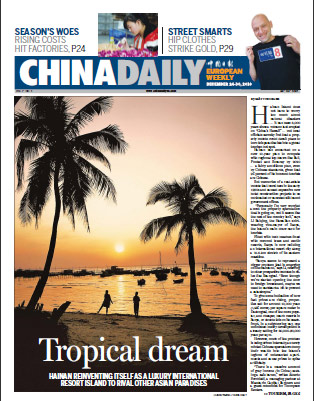Steelmakers seek lower ore price increase
Updated: 2006-12-04 14:06
By PAUL GLADER and PATRICK BARTA (WSJ)
As talks begin between the world's major steelmakers and iron-ore producers to set prices for next year, consensus is building that prices will rise between 5% and 10% and that the near-20% increase of this year won't be repeated.
Moreover, Chinese steelmakers, who failed in their attempt to resist iron-ore producers' demands this year, are intent on leading the talks and setting an industry pattern. Brazil's Cia. Vale do Rio Doce, the world's largest iron-ore miner, and Shanghai Baosteel Group Corp., one of the largest steelmakers in China, have been in early talks about the contracts, according to people familiar with the matter.
Iron ore is a crucial ingredient for making steel. Higher iron-ore costs could pressure steelmakers' financial results or lead to higher steel prices, and could raise the cost of making everything from washing machines to cars.
Unlike previous talks, when steelmakers were scrambling for supplies, the talks this year are set against a different industry backdrop. Demand for iron ore remains strong and supply tight, but not as tight as last year. Talks are also expected to proceed more quickly this year than last year when China's initial refusal to agree to a 19% increase dragged on for months.
Publicly, steelmakers and iron-ore producers are clashing, with some steel companies still saying the price of iron ore has reached an apex and iron-ore companies suggesting it hasn't. "The iron-ore market is tight," said Lakshmi Mittal, chief executive of Mittal Steel Co., the world's largest steel company by output and largest single iron-ore purchaser. "I do not expect an increase, but I do not see the iron-ore prices falling." Qi Xiangdong, deputy secretary general of the China Iron and Steel Association, said he expects the iron-ore price to change only by "a small margin" in 2007, either slightly up or slightly down. In some ways, a slight increase is in the best interests of Chinese steelmakers because it encourages smaller or midlevel iron-ore producers to develop more reserves and helps China weed out some of its small inefficient steelmakers that can't afford any price increase.
The world's three largest iron-ore producers -- CVRD, Rio Tinto PLC and BHP Billiton Ltd. -- aren't likely to give up their pricing power easily in coming months. Roger Agnelli, president of CVRD, has hinted iron-ore prices haven't topped out yet because the increase hasn't matched the surge in price for copper, another mined mineral with rising demand. Rio Tinto Chief Executive Leigh Clifford, in a presentation to investors in October, said Chinese import demand has been growing by 50 million metric tons or more a year and that iron-ore producers, despite "record levels" of investment in new iron-ore mines, are struggling to increase iron-ore production fast enough to keep up with the commodity boom.
"The industry has, in general, underestimated the enduring strength of demand," Mr. Clifford said. Such market tightness, his comments suggest, could justify higher contract prices. Some observers point out that other big costs for steelmakers such as for shipping and coal are more under control, meaning steel companies might be ready to accept a modest increase in the price of iron ore.
"The [iron-ore] producers are eager to get another price increase, and I see few ways to prevent them," said Daniel Altman, a steel analyst for emerging markets at Bear Stearns in New York. "It is not a question of if; it is how much."
The price of iron ore rose 19% in 2004, 71.5% in 2005 and 19% this year to the current price of about $44 per metric ton of iron-ore fines and $76 per metric ton of iron-ore pellets. Observers differ on their perspectives of pricing but tend to agree that price increases by iron-ore makers might be slowing and predict an increase of between 5% and 10% next year with prices flat or declining in the years that follow. Some, however, predict iron-ore companies will have the upper hand and continue increasing prices until 2009.
China has good reason to lead the talks. China produces and consumes about one-third of the more than one billion tons of steel produced globally each year, but it doesn't have plentiful cheap, high-quality iron-ore reserves. It plans to import about 320 million metric tons of iron ore this year and is increasing its internal iron-ore production as much as possible to minimize dependence on iron ore from Australia, Brazil and India.
To hedge against the increasing iron-ore prices, several steel companies such as Luxembourg-based Mittal and Pittsburgh-based U.S. Steel Corp. continue buying and developing their own mining assets and iron-ore reserves.
Paper's Digest

Jingle bells
The younger generation and every king of retailer are embracing the christmas holiday more than ever before across China.
Chinese shoppers boost luxury market
Growing appetite for foreign firms
Happiness quotient
Specials

If you're happy and you know it
Chinese J.K. Rowling's best-selling children's works are rapidly finding a foreign audience

Clothes maketh this man
English entrepreneur pioneers hip streetwear culture and becomes one of the locals in old Beijing.

Ich bin ein Beijinger
German sinologist's lifelong connection with China is deeply rooted.
